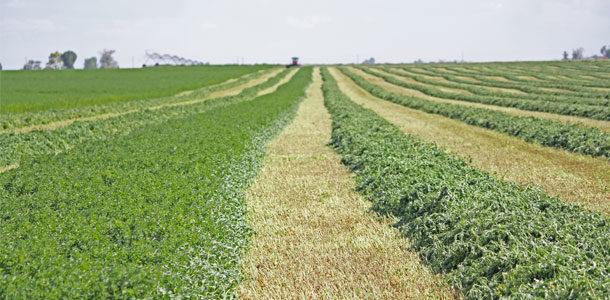A PDPW World-Class Webinar with Dr. Dan Undersander titled, “Cropping for Forage Rewards,” explained ways in which producers can maximize alfalfa yields.
The webinar was part of a series provided by PDPW. Undersander, a University of Wisconsin extension professor and agronomist, focused on three key elements producers should keep in mind this growing season during the first of three webinars that will take place throughout the summer.
Undersander discussed aspects of hay production and marketing, including risks of buying standing hay, alternatives to improve thickness of alfalfa, and maintaining quality forage.
Risks of buying standing hay
The buyer assumes a greater risk of investment due to growing conditions, the unknown quality of forage, as well as the timeline of when the field is being purchased in relation to the harvest date; all of these conditions affect potential yield.
A common misconception that many are unaware of when buying standing hay is what is being purchased and sold.
“Typically, people want to buy and sell by the acre,” Undersander said. “At the same time, recognize that yield can vary up to 50 percent or more among fields, which results in a variety of tonnage.”
Undersander reminded producers that when buying dry matter, the cows are eating tonnage.
Lastly, he said the prices might vary depending on insecticides and fertilizers used and who is harvesting the crop.
“First-cutting, standing forage may range from $120.00 to $150.00 per ton, and even more for a higher quality and yield,” Undersander said. “Prices tend to vary with the local market and what can be sustained.”
Alternatives to improve thickness of alfalfa
Undersander focused on what can be done to improve thin alfalfa stands by interseeding and crop rotation.
“We have done a lot of research that tells us we need at least 55 stems per square feet for maximum yield,” Undersander said.
It becomes essential that producers check their fields for stem count to determine potential yield. Equipment provided by companies, Undersander said, such as Winfield Solution’s round square foot, allows producers to check stem count.
Undersander suggests testing two or three areas within the field to recognize what stem count and estimated potential yields.
“If a field has less than 55 stems per square foot, there is not much anyone can do,” said Undersander. “You have to realize that the yield isn’t going to be as high.”
While interseeding with grasses to improve yield may be beneficial for a few, Undersander highly suggests not interseeding, but rather starting over.
Through several trials conducted under Undersander’s advising, it has been proven that a producer is better off turning over a thin alfalfa stand until next year to aid in a rotational benefit.
“Based on trial data, interseeding does not work as well as we would have hoped,” Undersander said. “We have seen a 15 percent increase in corn yield on an alfalfa ground and similar results with corn silage. Consider the rotational benefits of turning over a thin stand before interseeding.”
Maintaining quality forage
The final element producers should keep watch of during this growing season is the ability to manage quality forage.
First cutting tends to be of a higher quality due to an increase in digestible fiber from the cool weather that the alfalfa is able to grow in. As the growing season continues, digestibility decreases with the warmer weather.
Also noted by Undersander is the NDF digestibility as percent of dry matter of grasses and alfalfa is maintained in the leaves throughout the different stages of maturity.
“Unlike the stem, leaves remain 60 to 70 percent digestible throughout all stages – vegetative, flowering and seeding,” said Undersander.
If producers have experienced leaf loss on the forage, that is a clear sign that the field has encountered a leaf disease. Applying a fungicide before first cutting will reduce the prevalence of disease, if applied at the right time.
Furthermore, to maintain the quality of forages, Undersander advises all producers to sample the forage regularly and analyze the NDF values.
“It is better to know what is expected rather than have the cows tell you later on through a loss in milk production,” said Undersander.
For more information about alfalfa stands, please visit the University of Wisconsin – Forage Research and Extension website. Or visit their new Team Forage website. FG










